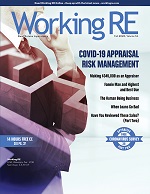 |
“One of the best courses that I have had in 17 years!” -Amy H
>> OREP E&O |
OREP/WRE Coronavirus Appraiser Blog
Coronavirus Appraiser Survey
>> New Survey: Appraiser Coronavirus Survey Part 2: What’s Changed?
USPAP: A Living (and Changing) Document – Part 1
By Philip G. Spool, ASA
In doing reviews I occasionally still see appraisal reports referred to as either a Self-Contained Appraisal Report or a Summary Appraisal Report. Evidently, the appraiser was not aware that this description ended with the 2014 Uniform Standards of Professional Appraisal Practice (USPAP). I then start to wonder what other changes appraisers are not realizing despite taking the required seven-hour USPAP update course every other year. Consequently, my goal with this article is to summarize the evolution and the significant changes made to USPAP from its inception through the USPAP of today.
This article includes multiple references to “significant” changes in USPAP, which I define as changes that affect the way the appraisal report is developed (Standards Rule 1) and reported (Standards Rule 2). Excluded in this article are any changes or additions to the Advisory Opinions. While they are important, they are not considered part of USPAP as stated in the second paragraph in the foreword to the USPAP advisory opinions: “Advisory Opinions are not part of USPAP.”
Origins of USPAP
Prior to the conception of USPAP as we know it today, the Federal Home Loan Bank Board (FHLBB) issued Memorandum R41b sometime between 1985 and 1986. While not a regulation, R41b contained guidelines used by FHLBB examiners in determining appraisal services. Primary users included savings and loans institutions, which provided residential loans, and commercial banks, which provided loans on commercial properties. Memorandum R41b did not include specific provisions concerning appraisal independence, hence the subsequent creation of The Appraisal Foundation (TAF), which created the Appraisal Standards Board (which oversees USPAP) and the Appraisal Qualifications Board (which oversees licensing requirements).
The original USPAP was developed in 1986-1987. The effective date of USPAP was April 27, 1987. Title XI of the Financial Institutions Reform, Recovery, and Enforcement Act (FIRREA) of 1989 required each agency to prescribe appropriate standards for the performance of real estate appraisals in connection with federally related transactions. All years prior and up to 2006 had new USPAP editions.
The 2006 edition was effective July 1, 2006 and ever since then, the USPAP edition was effective for two years and is published every other even year. The current USPAP edition is from January 1, 2020 through December 31, 2021. The Appraisal Foundation’s Appraisal Standards Board (ASB) meets periodically and requests public comment for possible changes to the current USPAP. Typically, the ASB finalizes the immediate future USPAP by the end of March 31st of the odd year.
1992 USPAP
Rules as we know them today, which follow the Preamble and Definitions, were known as Provisions, such as the Ethics Provision, Competency Provision, Departure Provision, Jurisdictional Exception and Supplemental Standards. Eventually they were replaced with the Ethics Rule, Records Keeping Rule, Competency Rule, Scope of Work Rule and the Jurisdictional Exception Rule. The Departure Provision allowed limited departure from sections of USPAP that were classified as specific guidelines rather than binding requirements. Any Standard that did not state: “Departure from this binding requirement is not permitted,” allowed the appraiser to limit his assignment to be performed.
The Departure Provision stated that prior to entering into an agreement: (1) the appraiser has determined that the appraisal or consulting process to be performed is not so limited that the resulting assignment would tend to mislead or confuse the client or the intended users of the report; and (2) the appraiser has advised the client that the assignment calls for something less than, or different from, the work required by the specific guidelines and that the report will clearly identify and explain the departure(s). What is interesting is that rather than the Departure Provision indicating the appraiser performed an “appraisal report,” it was referred to as an “assignment” or an “assignment to be performed.” The burden of proof was on the appraiser to decide before accepting a limited assignment that the result will not confuse or mislead. The burden of disclosure was also on the appraiser to report any limitations. This remained the same for the 1993 and 1994 USPAP.
It should be noted that the Departure Provision was the precursor to the current Scope of Work Rule in that the Departure Provision stated what was not performed.
1995 USPAP (Major Revision)
1995 was the first year that USPAP indicated any particular wording for types of appraisal reports, which were Self-Contained Appraisal Report, Summary Appraisal Report, or Restricted Appraisal Report. It should be noted that Self-Contained Appraisal Report, Summary Appraisal Report and Restricted Appraisal Report labels for reports ended December 31, 2013. The Departure Provision also added the following: “(3) The client has agreed that the performance of a limited appraisal or consulting service would be appropriate.”
No significant changes in 1996, 1997 and 1998.
1999 USPAP
The word “Provision” was changed to “Rule.” Restricted Appraisal Report was changed to Restricted Use Appraisal Report. Intended Use and Intended User were also added.
Total revamp of Standard Rule 1-2
SR 1-2 (a) incorporated the words “Intended Use” and SR 1-2 (b) incorporated the words “Intended User”; also the word “opinion” replaced the word “estimate” when defining the value. Also added was: “identify the effective date of the appraiser’s opinions and conclusions,” which was not mentioned before.
2000 USPAP
The Confidentiality section of the Ethics Rule replaced the wording from “Confidential factual data” to “Confidential information.” The Competency Rule added additional competency requirements other than geographical. The change was “an appraiser’s familiarity with a specific type of property, a market, a geographic area, or an analytical method.” Standards Rule 1-2 (f) was modified to identify more specifically the parties associated with the appraiser’s scope of work obligations and therefore, the phrase “third party” was replaced with “the client, an intended user, or the appraiser’s peers in the same or a similar assignment.”
2001 USPAP
Standards Rule 2-3 in the comments section added “An appraiser who signs any part of the appraisal report, including a letter of transmittal, must also sign this certification.”
2002 USPAP
Prior to 2002, the definition of Supplemental Standards was “an assignment performance requirement that adds to the requirements in USPAP.” In the 2002 USPAP, the definition of Supplemental Standards (since retired December 31, 2017) was modified to indicate that Supplemental Standards are “requirements issued by government agencies, government sponsored enterprises, or other entities that establish public policy, which add to the purpose, intent and content of the requirements in USPAP, that have a material effect on the development and reporting of assignment results.”
However, of utmost importance was the added comment “Contractual agreements that are unique to the contracting entity and which apply specifically to a particular property or assignment are not supplemental standards.” What this meant was that any requirements by your client that are not published in regulations, rules or policies were not considered Supplemental Standards and therefore, requirements by your client did not necessarily mean they were a USPAP requirement. In 2002, USPAP did not have a Scope of Work Rule which laid out the requirements that an appraiser must abide by in USPAP.
2003 USPAP
Standards Rule 1-5 modified the time period when the appraiser analyzes prior sales of the property. Up through 2002, the time period was one year for one-to-four family residential properties and three years for all other property types. Effective in 2003, all sales of the subject property that occurred within the three years prior to the effective date of the appraisal must be analyzed (not just stated) in the report, regardless if it is a one-to-four family residential property or other type of property. The three-year reporting is based on the prior three years to the effective date of the appraisal. The last portion of the 2002 USPAP Standards Rule 1-5 was made into a separate new Standards Rule 1-6 in 2003, which states the appraiser must reconcile the quality and quantity of data available and to reconcile the applicability or suitability of the approaches used to arrive at the value conclusion. This Standards Rule contains binding requirements from which departure is not permitted.
2004 USPAP
The 2004 USPAP was the last year that the Standards Rule 1-3 (b) comments section indicated that land should be valued as if vacant and available for development in accordance with its highest and best use. This portion was removed from SR 1-3 (b) in the 2005 USPAP edition as it was considered methodology and not a part of standards.
> Don’t miss Part 2 of this story next week to see the rest of USPAP’s major changes!
>> New Survey: Appraiser Coronavirus Survey Part 2: What’s Changed?
About the Author
Philip G. Spool, ASA, is a State-Certified General in Florida, appraising over 36 years. Formerly the Chief Appraisal of Flagler Federal Savings and Loan Association, he has been self-employed for the past 18 years. In addition to appraising, he is an instructor with Miami-Dade College, teaching beginning and advanced residential appraisal classes as well as continuing education. He can be reached at pgspool@bellsouth.net.
Sign Up Now! $119 (7 Hrs)
OREP Insured’s Price: $99
>Opt-In to Working RE Newsletters
>Shop Appraiser Insurance
>Shop Real Estate Agent
Insurance
Send your story submission/idea to the Editor:
isaac@orep.org





by JoAnn Apostol
Your article is good. I really enjoyed it, and it is one of the best walk-through of the history of the changes. However, USPAP does allow any term added to the required “Appraisal Report” or “Restricted Appraisal Report” options. The idea is minimum requirements which is what USPAP is founded on. Using “Summary” or “Self-Contained” in addition to the required names of the reports does not indicate a violation of USPAP, nor does it mean students haven’t taken the 7-hour update course. It may mean they have been given a greater understanding of the requirements. I still see appraisal requests from lenders come across using those terms as well.
-by George Tate
Just another way to sell another USPAP book. Since the damn thing is a government guide, it should be public domain.
-by Steven Smith
At the risk of dating myself, the R41 memoranda series started in 1978. R41C came out in the 1980’s.
-